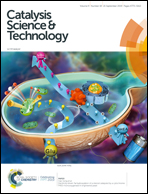Controlled synthesis of bifunctional 3D BiOBr:Eu3+ hierarchitectures with tunable thickness for enhanced visible light photocatalytic activities and mechanism insight†
Abstract
In this work, bifunctional 3D BiOBr:Eu3+ hierarchical nanostructures (HNs) assembled from 2D nanosheets with adjustable thickness were successfully fabricated via a solvothermal method by altering the amount of sodium citrate. The addition of sodium citrate effectively reduced the thickness of self-assembled nanosheets from 56 nm to 25 nm. The effects of thickness on the photoluminescence (PL) and photocatalytic activities of BiOBr:Eu3+ HNs had been systematically investigated. The results showed that the red emission of Eu3+ and the photocatalytic efficiency in degradation of MB were both improved significantly as the thickness of the nanosheets decreased. Upon excitation with blue light (465 nm), the BiOBr:Eu3+ HNs exhibited intense red emission corresponding to the 5D0 → 7F2 transitions of Eu3+ ions. Structural insights into the PL of Eu3+ ions revealed that the internal electric field (IEF) in BiOBr HNs increased significantly with decreasing sheet thickness, which improved the excitation field of Eu3+ ions and favored photogenerated charge separation and transfer. This work not only provided a new thought for understanding the photoreactivity through dopant PL, but also provided a platform for fabricating multifunctional materials for environmental and energy conversion applications.



 Please wait while we load your content...
Please wait while we load your content...